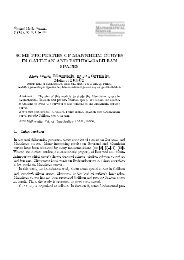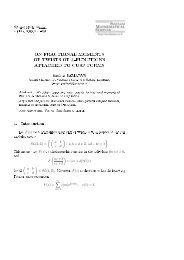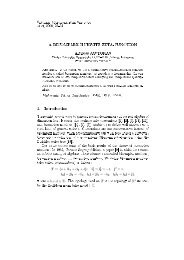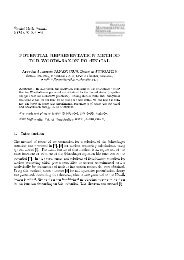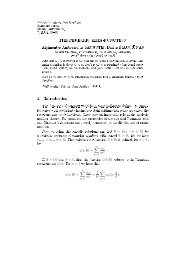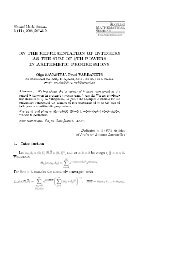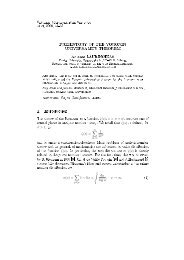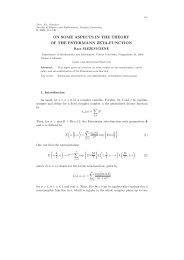a limit theorem for the hurwitz zeta-function in the space of analytic ...
a limit theorem for the hurwitz zeta-function in the space of analytic ...
a limit theorem for the hurwitz zeta-function in the space of analytic ...
You also want an ePaper? Increase the reach of your titles
YUMPU automatically turns print PDFs into web optimized ePapers that Google loves.
82 A <strong>limit</strong> <strong><strong>the</strong>orem</strong> <strong>for</strong> <strong>the</strong> Hurwitz <strong>zeta</strong>-<strong>function</strong>...<br />
Pro<strong>of</strong>. By choice <strong>of</strong> σ 1 and σ we have that σ+σ 1 > 1. Consequently, <strong>the</strong> <strong>function</strong><br />
ζ(s + z, α) <strong>for</strong> Rez = σ 1 , is represented by an absolutely convergent Dirichlet series<br />
Let<br />
Consider <strong>the</strong> series<br />
S<strong>in</strong>ce<br />
ζ(s + z, α) =<br />
a n (m, α) = 1<br />
2πi<br />
a n (m, α) = B(m + α) −σ 1<br />
∞∑<br />
m=1<br />
∫ ∞<br />
−∞<br />
∞∑<br />
m=1<br />
1<br />
(m + α) s+z .<br />
σ 1+i∞ ∫<br />
σ 1 −i∞<br />
l n (s, α)ds<br />
s(m + α) s .<br />
a n (m, α)<br />
(m + α) s . (7)<br />
|l n (σ 1 + it, α)|dt = B(m + α) −σ 1<br />
,<br />
<strong>the</strong> series (7) converges absolutely <strong>for</strong> σ > 1 2<br />
. Thus, <strong>in</strong>terchang<strong>in</strong>g sum and <strong>in</strong>tegral<br />
<strong>in</strong> <strong>the</strong> def<strong>in</strong>ition <strong>of</strong> ζ 2,n , we f<strong>in</strong>d<br />
By Lemma 6<br />
ζ 2,n (s, α) =<br />
∞∑<br />
m=1<br />
{<br />
a n (m, α) = exp −<br />
There<strong>for</strong>e <strong>the</strong> equality (8) can be writen as<br />
ζ 2,n (s, α) =<br />
∞∑<br />
m=1<br />
{<br />
1<br />
(m + α) s exp −<br />
a n (m, α)<br />
(m + α) s . (8)<br />
( ) σ1<br />
}<br />
(m + α)<br />
.<br />
(n + α)<br />
( ) σ1<br />
}<br />
(m + α)<br />
,<br />
(n + α)<br />
<strong>the</strong> series be<strong>in</strong>g absolutely convergent <strong>for</strong> σ > 1 2 .<br />
Now we change <strong>the</strong> contour <strong>in</strong> <strong>the</strong> <strong>in</strong>tegral <strong>for</strong> ζ 2,n (s, α). The <strong>in</strong>tegrand has<br />
simple poles at z = 0 and z = 1 − s. Let σ belong to σ ∈ [ 1 2<br />
+ ε, 1 − ε] when s ∈ K.<br />
We put<br />
Then by <strong>the</strong> residue <strong><strong>the</strong>orem</strong><br />
ζ 2,n (s, α) = 1<br />
2πi<br />
∫<br />
σ 2−σ+i∞<br />
σ 2−σ−i∞<br />
σ 2 = 1 2 + ε 2 .<br />
ζ(s + z, α)l n (z, α) dz<br />
z + ζ(s, α) + l n(1 − s, α)<br />
. (9)<br />
1 − s



